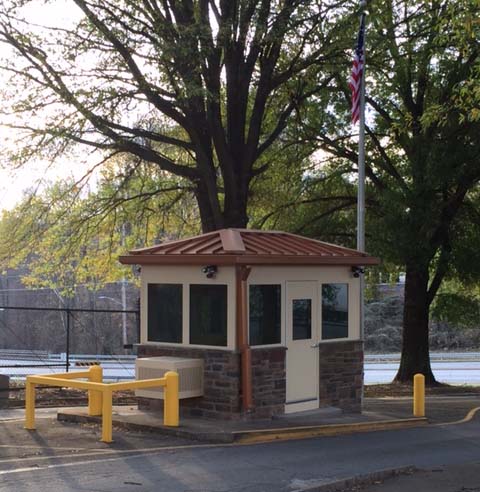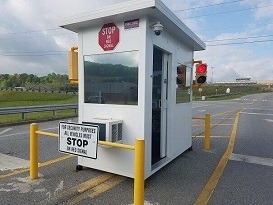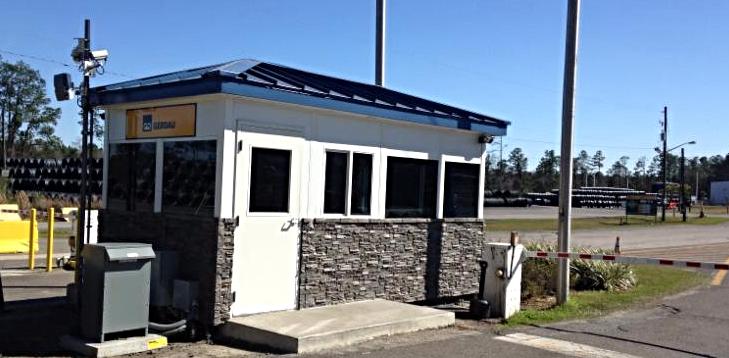Increasing School Safety Measures with a Guard Booth
Blog

It’s no secret that the United States has been focusing on keeping our schools as safe as possible. Over the course of the past 20 years, the National Center for Education Statistics has indicated 8 individual safety measures that schools take to help manage their security: controlled access to buildings during school hours, security cameras, wearable faculty badges or IDs, strict dress code, drug-sniffing dogs, student uniforms, wearable student IDs, and metal detectors.
Since the beginning of the 1990’s, the use of most of these measures has increased, except for metal detector checks. The safety measure increasing the most over this time has been the adoption of security camera systems to help monitor different aspects of the school, and the most common safety measure is the control access to buildings during school hours.
However, with school safety concerns growing over the years, perhaps it’s time to question whether these measures are enough?...
Let’s look at the safety measure that the NCES labels as the most prominent measure taken today, “controlled access to buildings during school hours.” Obviously, this should be a given. Random people should not be able to just walk into a school. However, in this case, the controlled access refers to “locking or monitoring doors during school hours.” The biggest problem with this is, if there is a breach of the access control system, the threat is already in the building before they are able to go into lockdown. Essentially, if the threat is able to break through this access control point, there is an immediate risk of danger to everyone inside the building.
There is no buffer zone between the breached access control point and the area in need of protection.

Creating a Multi-Layered Security system
Of the security measures taken by a school, the detection of a threat should take place as soon as possible, and that will always take place at the perimeter of the campus. Overall, a facility’s security should be comprised of three different layers in order to provide adequate security: the facility’s perimeter, the stand-off (or buffer) zone, and the building itself. By using “control access to buildings” a school is not taking advantage of the campus’s full safety measure arsenal.
This is the main point where guard booths are implemented, and they act in a couple major ways that benefit a school’s security team.
First, they act as the initial access control point for a facility and established a barrier to the campus. This is important because if a does enter the facility through this point, the guard posted there has the ability to radio to the school system that there is a threat on the campus, and from there, the school can go into lockdown mode.
In this scenario, the school’s entrances and exits will be locked, the students will be locked inside of a classroom or other safe room, and the rest of the school’s staff/security will be able to alert authorities and monitor the whereabouts of the threat. This situation is where the layered, 3-layer security design helps out school systems the most. It provides the school with time. Time to react to the threat for both the staff and the security team. And if the school has a security camera system, they can relay the subject’s location to the police in real time in order to have the threat minimized as soon as possible.
 Second, just the presence of a guard booth on a school campus shows an emphasis on their security and protecting their students and faculty. This emphasis is seen by both potential threats and the members of the school themselves. For potential threats to the campus, the guard booth acts a deterrent to potential crimes. And for the authorized entrants, it reminds them that this is a safe place for them to work and learn on a day to day basis. For larger campuses, there may be multiple points of entry, in which case multiple guard booths could be required.
Second, just the presence of a guard booth on a school campus shows an emphasis on their security and protecting their students and faculty. This emphasis is seen by both potential threats and the members of the school themselves. For potential threats to the campus, the guard booth acts a deterrent to potential crimes. And for the authorized entrants, it reminds them that this is a safe place for them to work and learn on a day to day basis. For larger campuses, there may be multiple points of entry, in which case multiple guard booths could be required.
More than An Access Control Point
In most cases, guard booths work well in conjunction with the other safety measures mentioned by the National Center for Education Statistics.
For starters, with all incoming traffic coming through this point, the guards are able to do a screening of the occupants to ensure they are following the safety standards. A checklist can be made to ensure each person entering has the correct credentials whether student, teacher or parent.
Additionally, the guard house can act as a hub for the rest of your security team. It can hold the monitoring station for your school’s security cameras, as well as hold the camera’s themselves. 
Also, all school guard booths should have installed a radio or communication station that can easily alert administration and the police to potential threats around the school. This is because the guard booth will not only act as the first line of defense for the school’s safety measures but should also be the first person to sound the alarm in case of an incident involving an outside threat.
In general, exterior lighting is always a plus for a guard booth to help with the vision of the guard inside. However, since the booth will typically operate during daylight hours, it is not as pertinent in this application.
As mentioned previously, physical security has been of growing importance over the last few decades. A variety of threats can come against a school system. For this reason, careful planning and design of a perimeter security system are vital for ensuring as much protection as possible. A multi-layered security system requires the proper systems to deter, detect, and respond to these incidents.
At Panel Built, we have delivered guard booths to schools and universities all across the United States, including the ones in our very own hometown. We always ensure to deliver these security solutions at the highest quality possible because it is what our country’s schools and students deserve. Don't let a monitored or locked door be the only thing between your school and a threat. If you are looking to give your school system a boost in security, give us a call at (800) 636-3873 or Request a Quote here on our site!